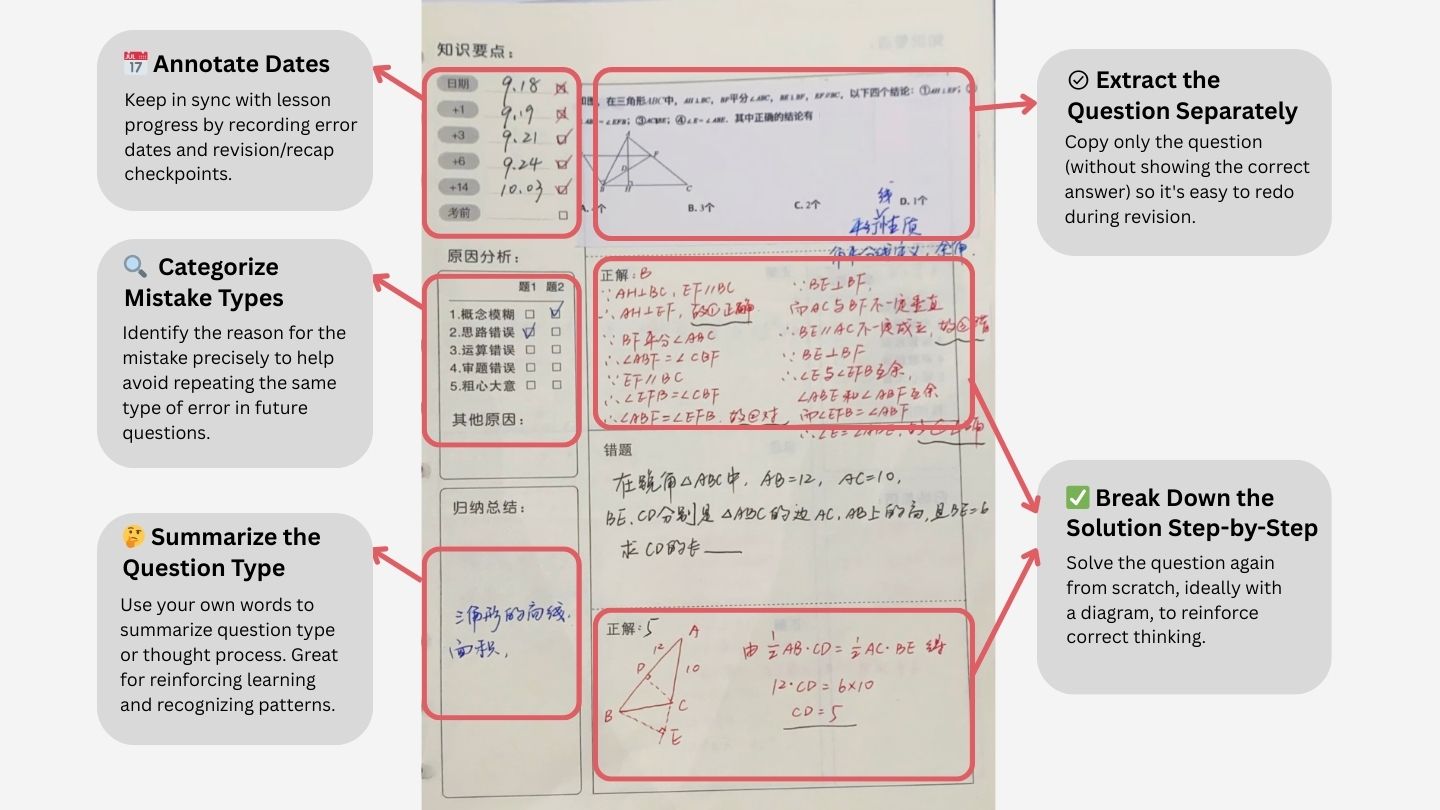本帖最后由 Nora老师 于 2025-5-7 17:53 编辑
Have You Been Using the Correction Book Wrong All Along?
90% of students fall into common traps when organizing their correction books. Is your child one of them? This scene might seem familiar to you:
“Mum, I know this already!” They say it confidently, finish their homework, and run off to play games or watch TV. But when the exam results come back, everyone is shocked: “Didn’t you say you understood it? Why are you making the same mistakes again?” Hold on! It might not mean your child isn’t trying hard. The real problem could be... they’re not using their correction book the right way.
What Makes a Correction Book Actually Useful?
Let’s break down: What a truly effective correction book looks like Why your child needs one The common "useless" ways most kids use them How top students organize theirs How to turn mistakes into improvements
Save this guide and help your child avoid common learning pitfalls!
What Is a Correction Book?
At its core, a correction book is where students record their mistakes. But its real value isn’t in recording, it’s in reflection and review.
But why do kids need a correction book?
A truly useful correction book is like your child’s personal learning manual. It helps them:
Pinpoint why they went wrong
Not just what they got wrong, but which knowledge point was weak, or which type of thinking led to the mistake.
Build their own problem-solving logic
Each correction is a mini self-teaching moment. Over time, it improves how they approach similar questions.
Boost revision efficiency
Before exams, they can quickly identify weak spots and review with focus. No more flipping randomly through books!
Common “Useless” Mistakes in Correction Books
Check is your child doing any of these? There are the common mistakes that could be holding your child back from real improvement ❌ Only pasting, no thinking: Neatly cut and pasted questions but no explanation of why they got it wrong.
❌ Messy & unorganized: All mistakes jumbled together, no category, making revision chaotic.
❌ Delaying entries: Waiting too long to record mistakes, by then, they forget the thinking process.
❌ Repeating careless errors: Rewriting "careless" mistakes over and over without learning anything new.
❌ Never reviewing: The book is written once and never opened again.
What Does a Top Student’s Correction Book Look Like?
Here’s a real example of a high-performing student’s correction book: clean, systematic, and effective!
2

Key features include: Full question included
Copy or paste the question clearly. Don’t write the correct answer right away and leave space to retry later.
Date clearly noted
Track when the mistake was made to align with learning progress.
Error type labele
Use labels like “Concept not clear” or “Misread question” to spot patterns over time.
Detailed solution steps + visuals
Not just the answer, but how you got there. For geometry or diagrams, include hand-drawn illustrations if needed.
One-sentence takeaway
Summarize what went wrong and how to avoid it next time, this builds “question sense” and transferable skills.
Three Steps to Using a Correction Book Effectively
After understanding what it looks like, here’s how to use it right, based on Kangaroo Study’s classroom-tested methods:
Step 1: Record Immediately + Repeat Practice
Don’t delay: Write down the mistake the same day. Note the question, the error, and your thoughts.
Retry the next day: Cover the answer and try again “blind.” This strengthens memory and recall.
Repeat until mastered: Getting it right once isn’t enough. Only repeated success shows true understanding.
Step 2: Sort by Error Type, Not Just Topic
Organizing by why you got it wrong is more helpful than just grouping by topic.
“Careless mistakes”: Misread units, copied the wrong number, etc. These don’t need full entries every time, but watch for frequency.
“Didn’t understand”: Missing concept, wrong method, logic errors, these are the points that need deep reflection.
For each one, write:
This builds structured, not scattershot, learning.
Step 3: Review Regularly and Reflect
Don’t wait until exam season to cram! Make your correction book part of your monthly study rhythm.
Every 2 – 4 weeks look back and ask: Which topics do I keep struggling with? Are my mistakes clustered in one area? Am I repeating the same type of error?
Set up a “summary page” to reflect: What knowledge points are still shaky? Which questions used to confuse me but I now understand? How has my problem-solving improved?
This review cycle helps build a personal knowledge map. And that’s how real progress happens✨
In Conclusion
A good correction book isn’t just for copying down wrong answers. It’s a powerful tool to help your child build self-awareness, develop learning strategies, and strengthen memory. When used correctly and consistently, it becomes a secret weapon in your child’s academic journey, boosting scores and helping them stand out in a competitive environment. At Kangaroo Study we always put the child at the center. We focus not only on results, but also on growth, mindset, and method.
We’ll continue to share more practical learning tips, so stay tuned✨
Is your child using their correction book correctly?
Message us with “Correction Book” and we’ll offer a free one-on-one review of your child’s mistake book with tailored advice from our team!
|